Have Chocolate, Will Travel
I have a long sticky love affair with sugar. Torrid does not even approximate it. One of my earliest memories, dating back to maybe when I was five, was of my father scooping me in his arms to bring me to a doctor as I could no longer walk what with my legs covered with pus-laden sores. They probably were simply infected mosquito bite marks but I distinctly recall being admonished by my parents that my blood turned sweet from the excessive sugary food I consumed and henceforth became too much an attractive fodder for mosquitoes.
To my vain defense, sweetness is probably the most attractive of all taste. We just have too many sweetness receptors in our tongue and mouth that we cannot help but be predisposed to seek it. Simple sugar metabolizes so fast as well that almost immediately after consumption, you get a boost in energy. Sugar rush is not an imagined phenomenon but a real sense of well-being craved by many an addict including me.
oh simple sugar
What we refer to as regular sugar is in chemistry, sucrose, a disaccharide made of glucose and fructose. It is naturally sourced from plants like sugar cane and sugar beet. An easy example of a goodie made of pure sugar is cotton candy. First, powdered sugar is heated and melted in a compartment. Then, liquefied mass is extruded through tiny holes while being spun. When the liquid comes in contact with cool air, the melted sugar quickly turns solid and wool-like. You could not make cotton candy any sweeter. Except for the food coloring, it is pure sugar, plain and simple. I can only laugh now at the old myth-cum-joke in the Philippines that cotton candy is made from sugar and dust. Impressionable that I was, I believed this tale until I knew better. Talking about pure sugar, the guiltiest pleasure when I was a kid was neither cotton candy nor taffy (balikutsa in Cebuano) but bread sandwiched with a tablespoon of sugar! Take that!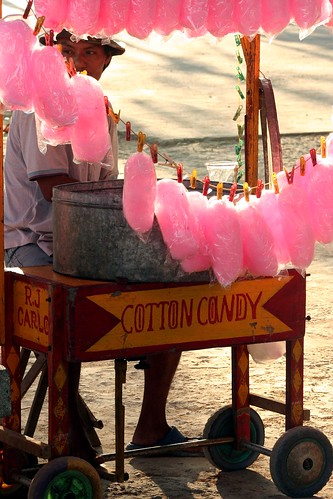
phototip: Cotton candy makers are everywhere but I looked for an old traditional maker to evoke a timeless quality to the image.
Canon EOS 350D, 0.005s, f/10, 85mm, ISO 800
traditional cotton candy maker by the town/church plaza of Madridejos, Bantayan Island, Cebu, the Philippines
remembering when M&Ms were beyond our reach
Back in the 80s, imported chocolate candies were quite expensive and out of our reach. Candies like M&M packs or Baby Ruths came straight from the US and were not affordable at all. I could count with the fingers of my hand the times I was able to try these out. I don’t even know what chocolate kisses look like until I was in high school. There was not any wanting though of local chocolate. My favorites in grade school were Manorhouse and Serg bars. My sister has other favorites which I think were Curly tops (the local equivalent of Reese butter cups) and locally franchised Tootsie rolls. In the late 80s, a slew of others were introduced successfully and I favored Big Bang. Of course in the 90s, multinational manufacturers wizened up and entered the market with Asian versions of their staples like the Hershey bar which no longer melt in our 27-30°C temperatures. Now, in any store, Snickers, Kitkats and the like are abundant and in democratized market prices.
phototip: Create or capture a story. The empty slots in this candy box showed that I could not wait and ate some marzipan candies by the time I finished shooting.
Canon EOS 350D, 15s, f/8, 31mm, ISO 100
American marzipan candies, Astoria, New York, the US
my local comfort
What we missed out from the imported candies was more than compensated by a plethora of native sweets. Filipino sweet fare typically incorporates local ingredients, the most popular of which are cane sugar, coconut, peanuts and sticky rice. There are NO brands really just a reference to the origin where it is made. We are basically talking about specialty products often made by an old lady. My favorites were my yaya’s biko (sticky rice cooked in coconut milk and caramel), piñato from Mandaue (peanut brittle), calamay from Bohol (caramel paste of ground peanut w/ coconut milk), Nang Didang’s masareal of Basak, Mandaue (molded cake of powdered peanut and sugar), bucarillos from Carcar (sugared coconut candies) and the consilva of Dumlog, Talisay. Those are just samplings as I cannot even begin enumerating all the delicacies that I like. Choices in the Philippines run to the hundreds as each province, if not island, has its own sweet delicacies.
When I began to travel, I still get drawn to local delicacies and not surprisingly, the Philippines share a serious commonality with Malaysia and Indonesia where sweet snacks are called jajan. Below is just one sampling, the dodol Medan. It is a confection of brown sugar (gula merah), coconut milk (santan), vanilla (vanili), ground sticky rice (tepung ketan) and sesame seeds (wijen). Delicious!
phototip: Ambient natural sunlight is not just dramatic but captures the colors as they are. This photo has no post processing at all.
Canon EOS 350D, 1.6s, f/11, 45mm, ISO 100, -1/3EV
bought in Sidoarjo, East Java but brought and photographed in Bali. Bali, Indonesia
the search for the sweetest fruits
One time in the 90s I attended a seminar and I sat beside one of the hosts who happened to be vegetarian. I remarked that his lifestyle must have made him so trim but he corrected me that not all vegetarians are thin. Some are obese too. How come? Well, carbohydrate consumption extraordinaire. I agree. If I were a vegetarian, I would be struggling with weight as I am now, probably because I cannot get my fill of fruits. Definitely, I always am on the lookout for the sweetest of anything be they mangoes, jackfruit, durian, atis, mangosteen or lanzones.
Fruits are sugar-packed and fruit sugar or sucrose is the sweetest of all natural sugars. Claiming which place produces which sweetest fruit is then like a wicked game. In the Philippines, I know that Cebu vociferously stakes a claim as having the sweetest variety but so does Guimaras. Personally, I would say that the sweetest mango I have ever tasted was in Selong, East Lombok. The household help in the staff house we were staying bought what they said were mangga madu (literally honey mango). When I first saw it, the fruit was unattractive. The pulp was pale and marbleized with unatttractive swirls of dark brown. But once I had a sample, I could not get enough of the concentrated sugar in those dark spots. It’s like eating precipitated caramel!
Unfortunately, I haven’t been able to have mangga madu ever since and even now, I have my doubts whether that was its name. Some Indonesia friends said it must be manalagi from Probolingo (East Java) which also has some orange spots of concentrated sugar as well. The sugar punch was not as concentrated. Or is just memory playing tricks on my taste buds? One day I would sure like to find out.
phototip: Arrange food around a curve.
Canon PowerShot S40, 0.167s, f/8, 12.3mm
popular varieties of sweet mangoes of East Java: the manalagi (foreground) of Probolingo with the orange spots of sugar and gadung (upper right, in bright orange) of Sitobondo, taken in Nganjuk, East Java, Indonesia
That said, I still will defend our very own Cebu mangoes as the finest overall. Certainly not a slouch in the sweetness department, Cebu mangoes are lusciously soft to the bite and not fibrous like the mangga manalagi and mangga madu. The skin is attractively bright yellow and the smell is sweet.
battling maladies
In tropical Philippines, sore throat is tonsilitis (inflammation of the tonsils). It is associated with eating too much sugar. For I crave sugar more than the next guy, tonsilitis became my personal perennial malady. Let’s just say that when I was growing up, I got sore throat attacks once every 2 months and the only 3 or 4 days in a year that I got too sick for school would be because of tonsilitis-induced high fever. I know the curative and preventive routine by heart: (1) skip anything sugary until the soreness goes away, (2) gargle hot saline solution for at least 1 minute immediately after eating something sweet and (3) sweat out the early signs of fever by exercise or massage; if not, the fever would only subside through medication. Antibiotics are the last recourse but I got too friendly with them that by the time I finally had my tonsils removed when I was 24 – that was when my EENT doctor finally diagnosed my tonsils as “too diseased to heal” – I already acquired immunity to at least 6 generic kinds. My bad!
Over time, I learned to eliminate certain sweet food groups to curtail my sugar intake. As young as when I was 8, I already decided to abstain from soda or softdrinks. I may get curious occasionally but in a year, I may only drink 2 bottles tops. By age 10, I voluntarily gave up sugar candies like lollypops, taffy, rock candies and licorice, even jelly beans. By high school, I limit my drinking of fruit juices– water was and still is my beverage of choice – although after college, I placed back fresh fruit juices in my diet and mind you, it is rather expensive getting fresh fruit juice (not reconstituted)! By the time, I already was working in my 20s, I realized that to remain healthy, I need to ration my sugar consumption so I eliminated the chocolates that commonly proliferate in the supermarkets, both local or imported, like Cadbury’s, Hershey’s and Mars. When I turned 30s, I added ice cream and ice sundaes to the eat-less category.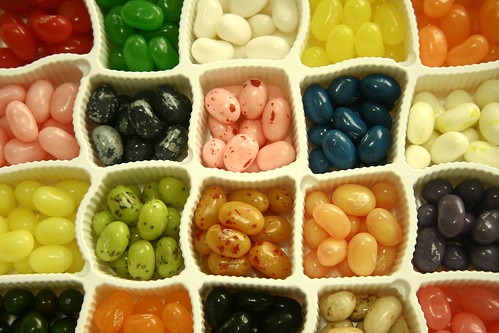
phototip: Try shooting straight up, or in this case, straight down.
Canon EOS 350D, 0.5s, f/5, 38mm, ISO 100, +2EV
imported jelly belly’s, taken in Cebu, the Philippines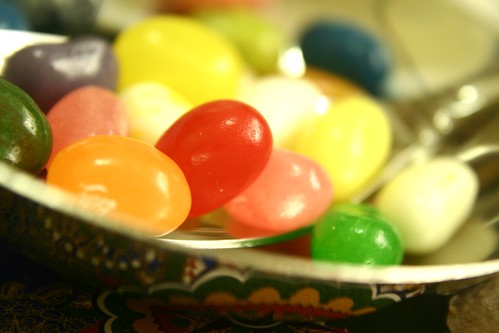
Canon EOS 350D, 0.6s, f/5.6, 55mm, ISO 100, +1/3EV
imported jelly belly’s, taken in Cebu, the Philippines
Needless to say, I’m left with no choice but to be picky nowadays. Health is a premium so I cannot go on eating too much sugar. Although we have no diabetes in our family, I am vigilant in checking my blood sugar every year (all normal thanks God!). I only got down with sore throat-related fever twice in the past 2 years, down from twice a year in the early part of the decade. This is a step up to the right direction.
There no denying that I still indulge on fruits, pastries and native goodies. I do, but in moderation (or so I claim). I am also not into cookies and biscuits although I always have bags of Pepperidge Farm’s Milanos at home. I still enjoy an occasional scoop of ice cream but only if it is Mövenpick, Häagen-Dazs, Godiva, Ben & Jerry’s or artisanal gelato. This painfully “expensive” taste extends to chocolates as well.
Before anyone will brand me snobbish, I compensate cost with quantity. The more expensive the gourmet chocolates, the smaller the amount that I can afford. De facto, I am limiting my sugar consumption! So occasionally in my travels, you can find me grabbing a pack of Neuhaus (Belgian), Anthony Berg (Danish) or Storck’s Toffifee (German). If I could I would hoard Nidar’s Troika (Norwegian), a bar made of thin slices of marzipan, truffles and red agar gel delicately wrapped in milk chocolate. Too bad they are not found in airports outside of Norway. At home, I always have a stash of chocolates in the cupboard. Here’s this month’s inventory: 2 Godiva cans, a Mirabell Mozartkugeln (Austrian) box, a pack of Grand Belgian Specialties and Paton’s Milk Macadamia Royals (Australian).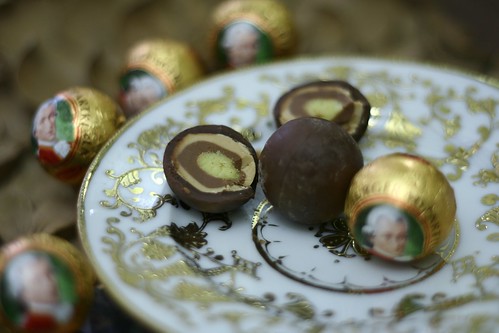
Canon EOS 350D, 0.3s, f/1.8, 50mm, ISO 100, +1/3EV
Mirabell’s Mozartkugeln chocolates, Cebu, the Philippines
emergency calls
If there is one thing chocolate never fails to deliver, it is easy calories and you never know when you are going to need them. I learned the lesson the hard way in 2005.
The place was Madagascar. I thought I converted enough dollars in the bank at the capital city of Antananarivo but at the tailend of our weeklong trip in Vohemar, I found out that I just had the right amount of local currency to pay for the hotel. Now, northeast Madagascar is a place without any credit card facility or any foreign exchange shop. Without any money, my sister and I found ourselves hungry at the Sambava airport when our 2PM flight was delayed to 4PM. Good for her to have gifted me a box of English truffles. This then became the lunch we shared.
Melted truffles never tasted that good.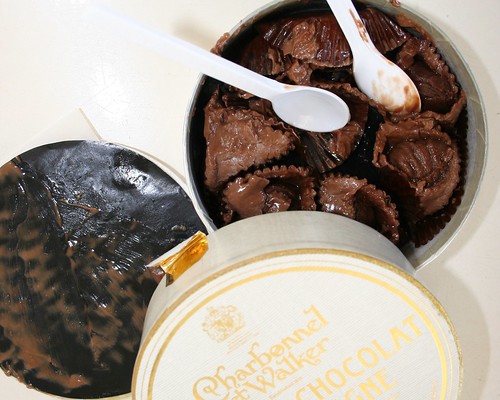
travel tips: Always have a box of chocolates. That and some plastic spoons that are given out in the plane. They will be useful for some sweet melted lunch.
Canon EOS 350D, 0.017s, f/4.5, 18mm, ISO 400
our only lunch at Sambava airport, Madagascar






1 comment:
sige kog basa sigeg tulo ako laway...
Post a Comment